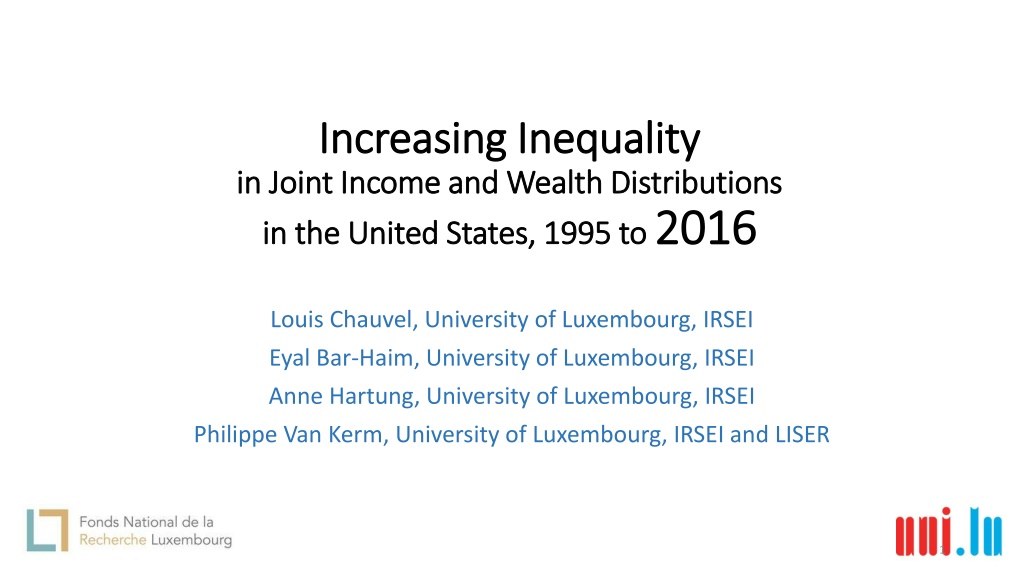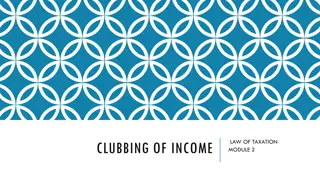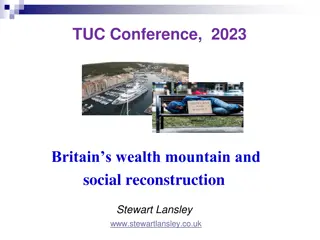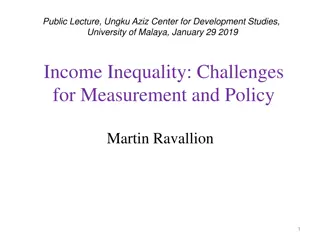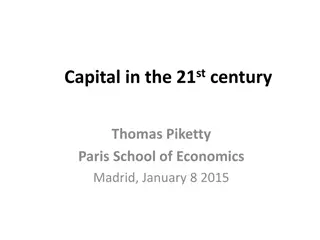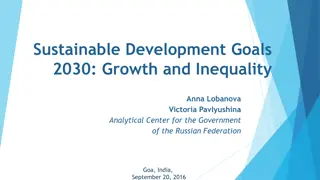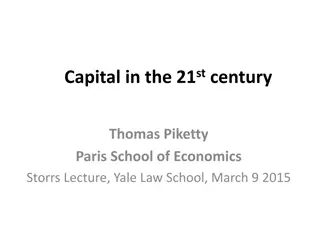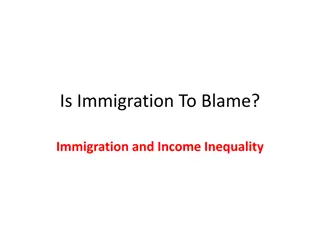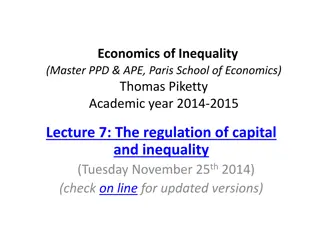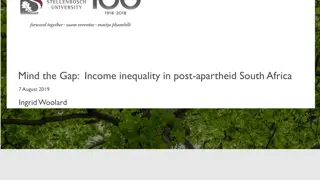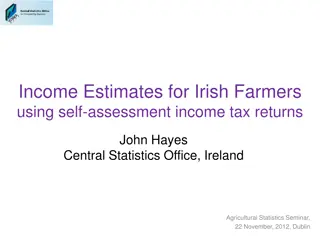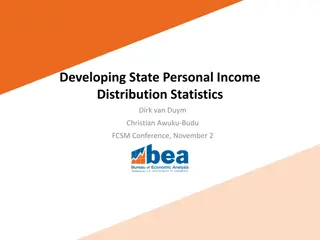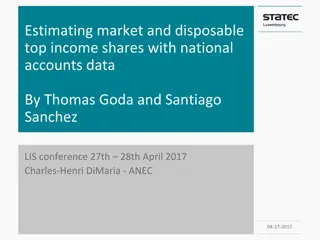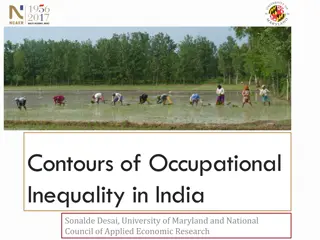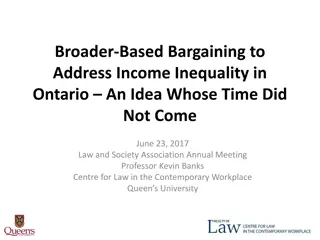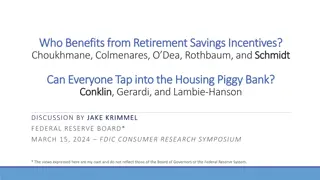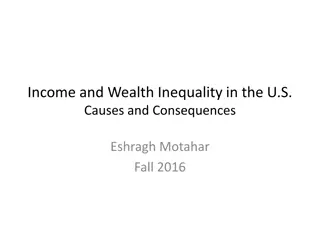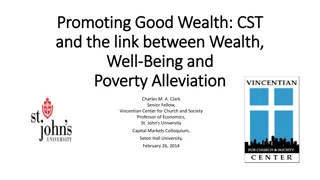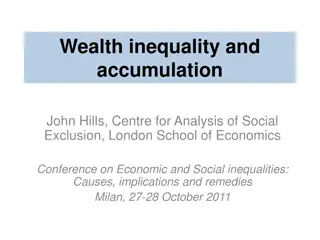Trends in Income and Wealth Inequality in the United States, 1995-2016
Recent research highlights the increasing inequality in joint income and wealth distributions in the United States from 1995 to 2016. The focus is shifting towards wealth distribution alongside income, revealing the rise in wealth inequality compared to income. Data limitations and skewed distributions pose challenges. Applications in finance and insightful studies contribute to the analysis of changing roles of merit and inheritance.
Uploaded on Sep 24, 2024 | 0 Views
Download Presentation

Please find below an Image/Link to download the presentation.
The content on the website is provided AS IS for your information and personal use only. It may not be sold, licensed, or shared on other websites without obtaining consent from the author. Download presentation by click this link. If you encounter any issues during the download, it is possible that the publisher has removed the file from their server.
E N D
Presentation Transcript
Increasing Inequality Increasing Inequality in Joint Income and Wealth Distributions Joint Income and Wealth Distributions in in the United States, the United States, 1995 in to 2016 2016 1995 to Louis Chauvel, University of Luxembourg, IRSEI Eyal Bar-Haim, University of Luxembourg, IRSEI Anne Hartung, University of Luxembourg, IRSEI Philippe Van Kerm, University of Luxembourg, IRSEI and LISER 1
Outline Background Focus on income AND wealth (I and W diagnoses can differ) Piketty, 2014; Wolff, 2016 Wealth to Income (W/I) ratio skyrocketed in many countries (Piketty as usual) Expect changing roles of merit and inheritance Killewald, Pfeffer, & Schachner, 2017 Expect massive changes between the 1990 s and the 2010 s All & al. 20xx Method ISOgraph a new way to detect level-specific inequalities and observe change New method for joint distributions Results Wealth inequality increased substantially and significantly Income inequality the same The upper-middle class benefitted more (in I and W) relatively to the top elite or the median Increasing importance of wealth over income in inequality (higher W/I ratio) 2
Income and Wealth Distributions Historically, Most studies of inequality focused on income However, recent studies put more emphasis on wealth distribution Piketty, 2014; Saez & Zucman, 2016 Pfeffer, Schoeni, Kennickell, Andreski, 2016, Wolff, 2016 etc Little is known about the joint distribution of income and wealth Jantti, Sierminska, Smeeding 2008, Jenkins, 2009, etcetc The problem: data limitations + methodological voids in wealth inequality analysis Extremely skewed distributions of wealth and income Small fraction of the pop. can control a considerable share of the resource 3
Applications => in finance (stock market dynamics) "Why Has CEO Pay Increased So Much?", Xavier Gabaix & Augustin Landier, Quarterly Journal of Economics, vol. 123(1), 2008, p. 49-100 = 1/ 1 4
Frank Cowell, Brian Nolan, Javier Olivera and Philippe Van Kerm 2017 Wealth, Top Incomes and Inequality, K. Hamilton and C.Hepburn (Eds.). Wealth: Economics and Policy, Oxford University Press. 5
Frank Cowell, Brian Nolan, Javier Olivera and Philippe Van Kerm 2017 Wealth, Top Incomes and Inequality, K. Hamilton and C.Hepburn (Eds.). Wealth: Economics and Policy, Oxford University Press. Saturation of inequality 6
Trends in overall inequality in wealth: Gini and Atkinson indices for the upper half of the distribution .8 .7 .6 .5 .4 1995 2000 2005 2010 2015 v2 Gini A(1) A(0.5) A(2) Source: LWS (US-SCF). Note: See Figure A.1 in the annex for the trends for the entire wealth distribution. 7
ISOGRAPH X = logit of the fractional rank r (=logitrank) of resource (income, wealth, etc.) [r between 0 and 1] Y = log medianized resource (resource divided by its median) ) X = ?????(?? ??????? Y = ln( ?????? ??????) ISO=Y/X is a measure of Level-specific inequalities ??????? ?????? ??????) ) ?????(?? ln( ???i= If ISO= (constant) Champernowne-Fisk (double Pareto) distribution with = Gini (Dagum, 1977) 8
ISOGRAPH Reading the ISOGRAPH (Chauvel, 2016; Chauvel & Bar-Haim, 2017) Each point represent ISO at the X (specific-level inequality) Differences in ISO at X level indicate variation in inequality levels The higher ISO, the higher contribution of this specific level to the overall inequality (=stronger stretch of the distribution) 9
ISOGRAPH Reading the ISOGRAPH Each point represent ISO at the X (specific-level inequality) Differences in inequality between levels indicate variation in inequality levels The higher ISO, the higher the inequality at this specific level (=stronger stretch of the distribution) 11
LIS examples of ISO on equivalized disposable income = level of living .6 dk1987 dk2010 de1978 de2010 fr1978 fr2010 .5 .4 .3 .2 .6 uk1979 uk2010 us1979 us2010 il1979 il2010 .5 .4 .3 .2 -4 -2 0 2 4 -4 -2 0 2 4 -4 -2 0 2 4 Graphs by col 12 Source: LIS data, various years and countries
Data LWS 1995 2016 (3 years intervals) 4200-6500 respondents each wave Stratified sample (=> complicated weights => confidence intervals = bootstrapping) large sub-sample of wealthy households Variables Income disposable income (after some taxes) per Consumption Unit Wealth current value of total marketable wealth and assets, net of debt 13
Initial Result U.K./U.S. comparison Net W (or the E.U. a bunch of outliers ) U.K. U.S. 2.5 2.5 This is almost a Zipf!!! 2 2 W isograph 1.5 1.5 W isograph 1 1 I isograph I isograph 0.5 0.5 0 0 -2 -1 0 1 2 3 4 5 6 7 -2 -1 0 1 2 3 4 5 6 7 x x Source: LWS 2013 and U.K. LWS 2011 14
Initial Results U.K./U.S. comparison Net W (or the E.U. a bunch of outliers ) 2.5 2.5 U.K. U.S. X 1 2 3 4 5 6 top p 0.269 0.119 0.047 0.018 0.007 0.002 x times med x times med 2.0 3.3 5.4 9.1 15.4 31.9 2 2 U.S. W isograph 3.6 9.4 24.9 68.4 147.4 268.3 Top 5%!!! 1.5 1.5 U.K. 1 1 I isograph 0.5 0.5 0 0 -2 -2 -1 -1 0 0 1 1 2 2 3 3 4 4 5 5 6 6 7 7 x Source: LWS 2013 and U.K. LWS 2011 15
Result 1 Income inequality increases U.S. Income .7 Significant increase in income inequality for incomes with logit rank of 2 (top 11%) and above. No significant change for the highest 2% and around the median income. .6 .5 2016 .4 1995 ISO Significant increase in income inequality .3 0 2 4 6 (0.500) (0.881) (0.982) (0.998) 1995 2016 Logitrank(Income) X=2 Top 11% X=5.5 Top 2% 16
Result 2 Wealth inequality increases Wealth Significant increase in wealth inequality for wealth above the median (logit rank 0). No significant change above the top 0.5% and around the median income. 1.8 1.6 2016 1.4 1.2 ISO Significant increase in W inequality 1 1995 .8 0 2 4 6 Logitrank(Wealth) 1995 2016 X=0.5 Top 38% X=5.5 Top 0.5% 17
Joint Distribution of Income and Wealth by Logitranks 1995 2001 2007 6 Using logitranks instead of percentiles, The association is much clearer. Especially in the upper part of the distribution. 4 2 Wealth 0 2010 2013 2016 6 4 2 0 0 2 4 6 0 2 4 6 0 2 4 6 Income 18
Result 3: stronger Income-Wealth Association (1992-2013) The income/wealth association became stronger over the years. Most of the increase is during the first decade of the 21st century. Log Logit .45 .4 .35 .3 Significant increase in the I x W association .25 1995 2000 R2 of Log(Income) x Log(wealth) 2005 2010 2015 1995 2000 2005 2010 2015 R2 of LR(Income) x LR(wealth) 19
Result 4: increasing Wealth to Income ratios (W/I) (in Years ) 20 Near to the top 2%, in 2016, Wealth=10 years of income 15 2016 Above to the Median, On both years, Wealth= 2 years of income 10 Significant increase in the W/I ratio 1995 5 Near to the top 2%, in 1995, Wealth=6 years of income 0 0 2 4 6 (0.500) (0.881) (0.982) (0.998) 1995 2016 20
Conclusions Only bad news for equality: Income and wealth inequality increased over the period (R1 & R2) Wealth inequality increased almost everywhere above the median (R2) The very top fractiles (above top 1%) are less significantly affected (data or reality?) The wealth-income association increased: even more consistent relation income rich and wealth rich are more and more the same ones (R3) The W/I ratio increased (R4) mostly near to the top decile from 7 to 11 years Plus initial result (R0): Wealth inequality in the U.S. is really exceptional (compared to Europe) R0, R1, R2, R3, R4: 5 synergetic aspects of increasing inequalities in the U.S. The 15 Proposals from Tony Atkinson s Inequality What can be done? Proposal 7: A public Investment Authority should be created, operating a sovereign wealth fund with the aim of building up the net worth of the state by holding investments in companies and in property. Idea to pursue: a re-examination of the case for an annual wealth tax and the prerequisites for its successful introduction. Idea to pursue: a global tax regime for personal taxpayers, based on total wealth. 21
